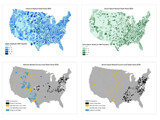New Penn Medicine Research Identifies Infection and Sepsis-Related Mortality Hotspots Across the U.S.
In the past, researchers have sought to determine the geographic distribution of many life-threatening conditions, including stroke and cardiac arrest. Now, researchers at the Perelman School of Medicine at the University of Pennsylvania have created the first U.S. map that pinpoints hotspots for infection and severe sepsis related-deaths – with notable clusters located in the Midwest, mid-Atlantic, and the South. The research is a critical first step in helping to determine which areas of the country require vital public health resources to fight these deadly diseases. The research was presented today at the annual meeting of Society for Academic Emergency Medicine in Atlanta, Ga.
“Infection-related deaths are a leading cause of morbidity and mortality in the U.S., affecting over 1 million people a year, and costing $17 billion annually,” said lead study author David Gaieski, MD, an associate professor of Emergency Medicine at Penn. “And while our understanding of the causes of infection-related death rates has improved, we are still struggling to prevent these diseases and indentify individuals who are most susceptible. We need to be able to pinpoint the geographic distribution of infection-related death rates in order to further study how and why these infections are happening in these areas and the best methods to prevent these deaths.”
Sepsis is the tenth leading cause of death in the United States. With an estimated 750,000 cases annually and a nearly 40 percent mortality rate, severe sepsis is also one of the most common causes of death in hospital critical care units.
To better understand what areas of the country are most at risk for severe sepsis and other infection-related deaths, the research team collected U.S. county death data from the 2010 Multiple Cause of Death data files (compiled by the National Center for Health Statistics) and combined it with 2010 Area Resource File demographic data for a comprehensive view of national variations. The authors note that previous research had only been able to identify potential trends on a state level.
Click here to view the full release.








